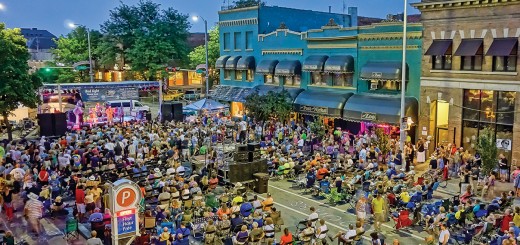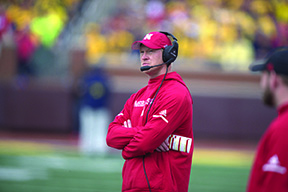Nebraska Football

by Ken Hambleton
Win or lose, the traditions of Nebraska football have never wavered.
From the beginning, when trainloads of Husker fans, actually fans of the Old Gold Knights at the time, traveled to Omaha in the 1890s to later treks to Iowa, Minnesota, the Midwest and the 1941 Rose Bowl, the Crimson and Cream—Red and White to the modern fans—have been a focal point in Nebraska.
Consider that Memorial Stadium and the iconic Nebraska State Capitol, just 10 blocks south of the stadium, were built at the same time.
If you know Nebraska, the sandhills, the farms and the prairie, you know of Nebraska football, too.
Nebraska football has always had a big part in the lives of the people who live here and those who live here in football spirit across the world.
Despite some lean years in terms of wins, even a 2020 season of conference-only games with no spectators allowed in Memorial Stadium, the Huskers still celebrate a sellout string for home games that started in 1962.
The Huskers, named Cornhuskers in 1904 after brief stints as Bugeaters, Old Gold Knights and Antelopes, captured the hearts and minds of football fans everywhere but, as the fight song says, no place like Nebraska.
Traditions are strong: the unity walk of fans and players to the stadium some two hours before kickoff, the Pride of Nebraska Marching Band parading 10th Street an hour before the game, releasing red balloons for the first touchdown, huge crowds in dozens of bars and restaurants, the human traffic jam in the Haymarket Railyard, and just about every nook and cranny that can hold a radio or a TV on a Saturday morning, afternoon or night.
The economic impact of Nebraska football boosts public coffers millions in tax dollars every home game. Heck, even the annual Red-White Spring game—the final intra-team scrimmage of the spring—garners 60,000-plus every April. And, of course, there are red shirts, blackshirts, red flags with the “N”, even corncob foam hats everywhere.
Note: if you want to be an insider, yell “Go Big Red.” The red shirts, red clothing, red everything picked up steam in the 1950s. The Black Shirts, tradition started in 1963 when assistant coach Mike Corgan, went to a local sporting goods store to get practice jerseys and black was on sale. Since then, the Nebraska defense has awarded black shirts to the starting players and fans picked up on the Black Shirt tradition when NU defenses were largely responsible for national championships in 1970, 1971, 1994, 1995 and 1997.
The Huskers reached three other national championship games during that span as well.
The heroes are part of the football lexicon of talking about the Huskers.
Heisman Trophy winners Johnny Rodgers, Mike Rozier and Eric Crouch, Outland Trophy winner Dave Rimington, All-American Rich Glover, Jerry Tagge, Jeff Kinney, Tommie Fraszier, Ndamukong Suh, Roger Craig, Irving Fryar, Grant Wistrom, Jason Peter, Mike Brown, Broderick Thomas, Dominic Raiola and dozens of others are Husker football legends.
Trev Alberts, an All-American defensive end, is the current Nebraska athletic director. Former quarterback Scott Frost, is the head coach.
Fans still speak with reverence of former Husker defensive coordinator Charlie McBride and offensive line coach Milt Tenopir.
There is awe of the great Tom Novak, whose No. 60 is the only number retired by Nebraska and still known as the toughest Husker ever. Guy Chamberlin, who starred in the 1910s, is a member of the National Football Hall of Fame, alongside former Nebraska guard Bob Brown. George Flippin, the first black player west of the Mississippi in the early 1900s, Forrest Behm, who was All-American and a later WWII war hero, Bobby Reynolds, Will Shields and Neil Smith, who became some of the all-time greats for the Kansas City Chiefs, Ahman Green and Tom Rathman, went on to become top pros as well.
That’s why long, long into every night during the season, even with less fortunate outcomes in recent years, thousands devour every word, written and spoken through dozens of new outlets throughout every season.
Nebraska football income, more than $100 million annually, supports the entire 23-sport program at the university and makes city, county and state treasuries bountiful.
The Huskers have enjoyed the seventh winningest program in the country, with 46 conference championships—including the years of coach Jumbo Stiehm in the early 1900s to the perennial national powers under legendary Bob Devaney and Tom Osborne from 1962 to 1997.
Devaney came to Nebraska from Wyoming in 1962 and brought the program to national prominence. Osborne, a graduate assistant coach under Devaney, took over the offense in 1969, then became head coach in 1973. The Huskers took five national titles, were ranked in the Top Ten almost every year during their run. Frank Solich, an assistant to Osborne, took over in 1998, and still Nebraska played in national championship games.
Since then, the ups and downs have pulled at the heartstrings of Nebraska football fans, but the hopes spring eternal.
The 35-bowl game streak ended a few years ago as well as the long cascade of winning seasons.
But hope springs eternal.
While Nebraska football dominates sports pages and even news cycles eight months a year, the other four months are led by Nebraska recruiting news, reports of winter strength conditioning, spring football practices and summer workouts.
It never ends.














Recent Comments